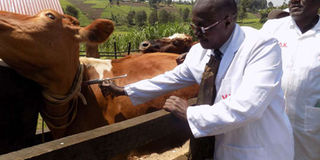Ministry issues alert on foot and mouth disease

Kirinyaga County executive in charge of Agriculture, Ngundo Warui, vaccinates a cow against foot and mouth disease, at Ndiriti village on August 2, 2016. PHOTO | GEORGE MUNENE | NATION MEDIA GROUP
What you need to know:
- The spread has partly been blamed on the ineffectiveness of the old vaccine used to protect cattle against the disease locally.
- The Kenya Veterinary Vaccines Production Institute has been producing vaccines to control the disease.
Livestock farmers are facing yet another crisis following an outbreak of foot and mouth disease, which has struck in the wake of an ongoing drought that has claimed tens of cattle.
The Ministry of Agriculture, through the State Department of Livestock, issued an alert on the dreaded disease that has affected different parts of the country.
The spread has partly been blamed on the ineffectiveness of the old vaccine used to protect cattle against the disease.
The Director of Veterinary Services, Dr Obadiah Njagi, also attributed a combination of uncontrolled livestock movement and low vaccination coverage to the fast spread of the viral infection.
NEW STRAIN
But of major concern is the emergence of a new strain of the virus that causes the disease, which has complicated matters for livestock owners.
“Some of the outbreaks were linked to an apparent new variant of serotype O that has hitherto not been detected in the country but is in circulation in neighbouring nations.
"The current vaccine may, therefore, have appeared to be unprotective,” Dr Njagi said in an advert on Tuesday.
The Kenya Veterinary Vaccines Production Institute, has been producing vaccines to control the disease.
Farmers have been using a water-based foot and mouth vaccine which, though effective, presented a number of challenges because it has a short shelf-life and has to be administered three times a year as its immunity lasts only 3-4 months.
This translated to high costs of vaccination and expiry of the vaccines when uptake was low.
VACCINE
But the country’s veterinary scientists, the official reported, are upgrading the vaccine to match all serotypes in circulation.
According to the 2009 animal census, Kenya was home to 17.5 million cattle, 17.1 million sheep, 27.7 million goats and 400,000 pigs.
Foot and mouth disease is endemic in Kenya and therefore the huge livestock resource can only be protected by vaccination.
Livestock diseases pose a challenge to dairy and beef production because they reduce productivity, increase the cost of treatment, or kill animals.
ECONOMY
Foot and mouth disease is one of the destructive diseases affecting cattle, pigs, goats and sheep and results in the imposition of quarantines which, in turn, affect trade in animal and animal products in the affected areas.
Dr Njagi said 84 outbreaks were reported last year, out of which 21 cases were in Nakuru, seven in Kiambu and six in Nairobi.
Other cases have been reported in Marsabit, Garissa, Kwale and Narok counties, which are experiencing drought according to statistics by the Ministry of Devolution and the Kenya Red Cross Society.





